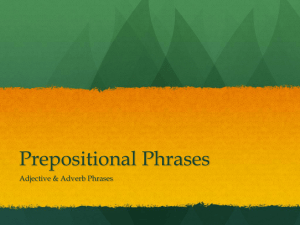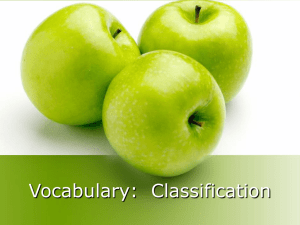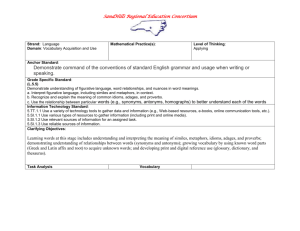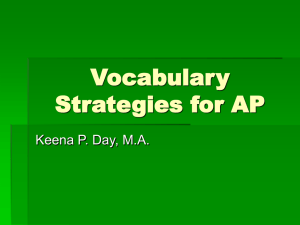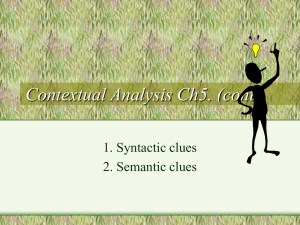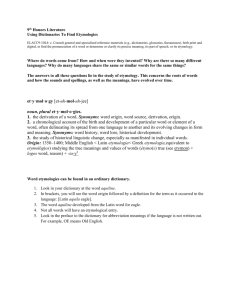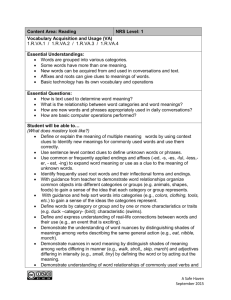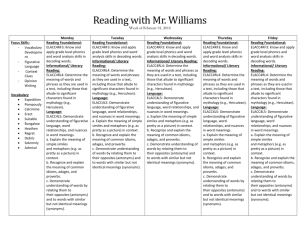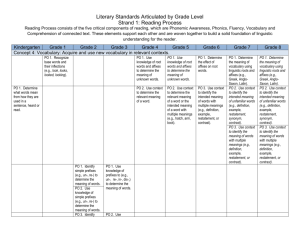Vocabulary - Mrs. Kevic` St. Patrick School
advertisement
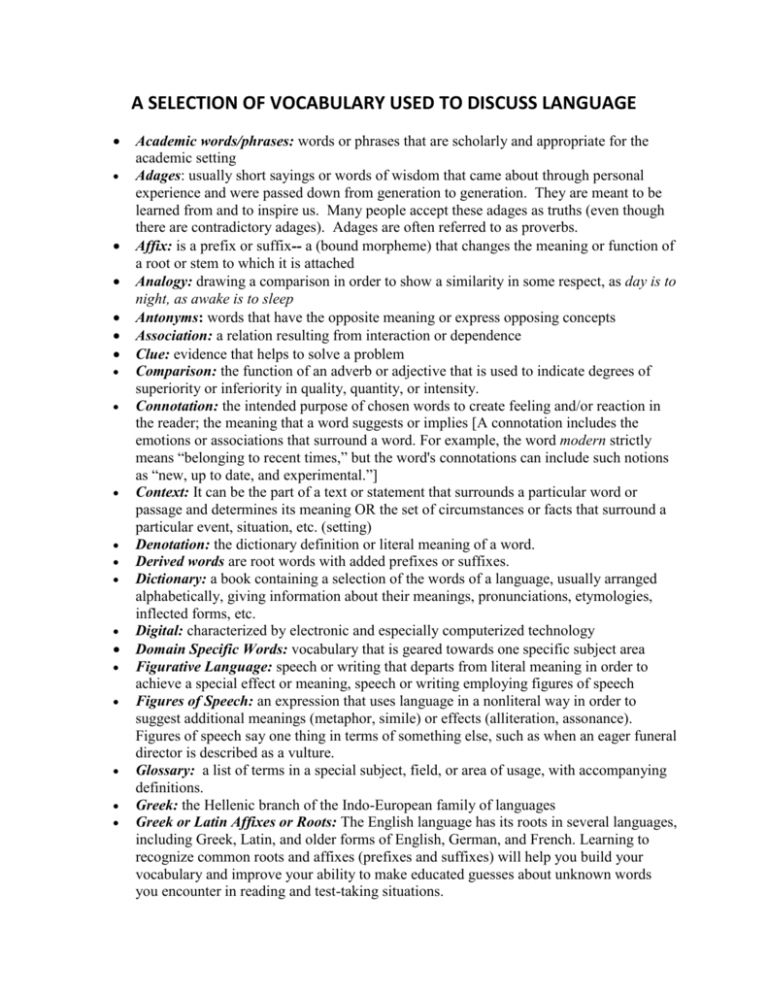
A SELECTION OF VOCABULARY USED TO DISCUSS LANGUAGE Academic words/phrases: words or phrases that are scholarly and appropriate for the academic setting Adages: usually short sayings or words of wisdom that came about through personal experience and were passed down from generation to generation. They are meant to be learned from and to inspire us. Many people accept these adages as truths (even though there are contradictory adages). Adages are often referred to as proverbs. Affix: is a prefix or suffix-- a (bound morpheme) that changes the meaning or function of a root or stem to which it is attached Analogy: drawing a comparison in order to show a similarity in some respect, as day is to night, as awake is to sleep Antonyms: words that have the opposite meaning or express opposing concepts Association: a relation resulting from interaction or dependence Clue: evidence that helps to solve a problem Comparison: the function of an adverb or adjective that is used to indicate degrees of superiority or inferiority in quality, quantity, or intensity. Connotation: the intended purpose of chosen words to create feeling and/or reaction in the reader; the meaning that a word suggests or implies [A connotation includes the emotions or associations that surround a word. For example, the word modern strictly means “belonging to recent times,” but the word's connotations can include such notions as “new, up to date, and experimental.”] Context: It can be the part of a text or statement that surrounds a particular word or passage and determines its meaning OR the set of circumstances or facts that surround a particular event, situation, etc. (setting) Denotation: the dictionary definition or literal meaning of a word. Derived words are root words with added prefixes or suffixes. Dictionary: a book containing a selection of the words of a language, usually arranged alphabetically, giving information about their meanings, pronunciations, etymologies, inflected forms, etc. Digital: characterized by electronic and especially computerized technology Domain Specific Words: vocabulary that is geared towards one specific subject area Figurative Language: speech or writing that departs from literal meaning in order to achieve a special effect or meaning, speech or writing employing figures of speech Figures of Speech: an expression that uses language in a nonliteral way in order to suggest additional meanings (metaphor, simile) or effects (alliteration, assonance). Figures of speech say one thing in terms of something else, such as when an eager funeral director is described as a vulture. Glossary: a list of terms in a special subject, field, or area of usage, with accompanying definitions. Greek: the Hellenic branch of the Indo-European family of languages Greek or Latin Affixes or Roots: The English language has its roots in several languages, including Greek, Latin, and older forms of English, German, and French. Learning to recognize common roots and affixes (prefixes and suffixes) will help you build your vocabulary and improve your ability to make educated guesses about unknown words you encounter in reading and test-taking situations. Homographs: a word of the same written form as another but of different meaning and usually origin, whether pronounced the same way or not. Idioms: phrases where the words together have a meaning that is different from the dictionary definitions of the individual words. Key words: word of the same written form as another but of different meaning and usually origin, whether pronounced the same way or not. Latin: an Italic language spoken in ancient Rome Multiple-meaning words: words that can be interpreted in many different ways Nuance: a subtle difference or distinction in expression, meaning, response, opinion or attitude Part of Speech: Traditional grammar classifies words based on eight parts of speech: the verb, the noun, the pronoun, the adjective, the adverb, the preposition, the conjunction, and the interjection. Each part of speech explains not what the word is, but how the word is used. In fact, the same word can be a noun in one sentence and a verb or adjective in the next. Personification: assigning human traits to things, ideas or qualities Precise meaning: exact meaning; clearly expressed or delineated Preliminary: designed to orient or acquaint with a situation before proceeding; a preliminary investigation Preliminary determination: introductory or preparatory step, leading up to the main part Print: the text appearing in a book, newspaper, or other printed publication Prior knowledge: accessed when word meaning can be gained or reasoned from past experiences. Pronunciation: the act or result of producing the sounds of speech, including articulation, stress, and intonation; how the word should sound when spoken. Proverbs: Words of Wisdom Reference materials: material to be consulted for basic information: internet, dictionaries, encyclopedia, text books, etc. Root: the basic part of the word; the form of a word after all affixes are removed Synonym: a word having the same or nearly the same meaning as another in the language, (e.g. joyful, elated, glad) Text Cues: allow a reader to take meaning from text. Types of cues include syntax, context clues, and prior knowledge. Thesaurus: a dictionary of synonyms and antonyms Unknown words: words that have unfamiliar meanings Vocabulary knowledge: understanding of the meaning of a word Word relationships: words that share some sort of connection (e.g. synonyms, homonyms, and antonyms)
